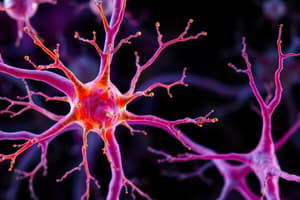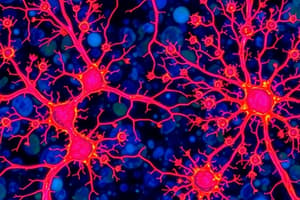Podcast
Questions and Answers
What do Nissl bodies correspond to in other cells?
What do Nissl bodies correspond to in other cells?
- Smooth endoplasmic reticulum
- Rough endoplasmic reticulum (correct)
- Golgi apparatus
- Mitochondria
What are neurofibrils?
What are neurofibrils?
Network of fine threads within a nerve fiber that support it.
What is the function of a dendrite?
What is the function of a dendrite?
Conducts an impulse toward the cell body.
What is a collateral in the context of a neuron?
What is a collateral in the context of a neuron?
What is an astrocyte?
What is an astrocyte?
What does an axon do?
What does an axon do?
What is the role of an interneuron?
What is the role of an interneuron?
What is a motor (efferent) neuron responsible for?
What is a motor (efferent) neuron responsible for?
What does a sensory (afferent) neuron do?
What does a sensory (afferent) neuron do?
What is the function of an oligodendrocyte?
What is the function of an oligodendrocyte?
What is a microglia?
What is a microglia?
What is an effector?
What is an effector?
What does the ependyma do?
What does the ependyma do?
What is a synapse?
What is a synapse?
What is a neurotransmitter?
What is a neurotransmitter?
What does CNS stand for?
What does CNS stand for?
What does PNS stand for?
What does PNS stand for?
The three general functions of the nervous system are: sensory - receiving information, integrative - deciding what to do, and motor - acting on decisions. The sensory function refers to _____
The three general functions of the nervous system are: sensory - receiving information, integrative - deciding what to do, and motor - acting on decisions. The sensory function refers to _____
The autonomic nervous system controls smooth muscle, cardiac muscle, and glands and is _____
The autonomic nervous system controls smooth muscle, cardiac muscle, and glands and is _____
The stored electrical energy across a cell membrane due to the unequal distribution of ions is known as _____
The stored electrical energy across a cell membrane due to the unequal distribution of ions is known as _____
The sequence of electrical changes in nerve or muscle cell exposed to a stimulus that exceeds threshold potential is known as _____
The sequence of electrical changes in nerve or muscle cell exposed to a stimulus that exceeds threshold potential is known as _____
What is a threshold potential?
What is a threshold potential?
What is a trigger zone?
What is a trigger zone?
What is a refractory period?
What is a refractory period?
What is the process of saltatory conduction?
What is the process of saltatory conduction?
What is an excitatory neurotransmitter?
What is an excitatory neurotransmitter?
What is an inhibitory neurotransmitter?
What is an inhibitory neurotransmitter?
Flashcards are hidden until you start studying
Study Notes
Nervous System Overview
- Nissl Bodies: Correspond to rough endoplasmic reticulum; involved in protein synthesis; scattered in neuronal cytoplasm.
- Neurofibrils: Fine thread network within the nerve fiber; provide structural support to the axon.
- Dendrites: Branching neuron processes that receive impulses and direct them towards the cell body.
- Collateral: Branching extensions of an axon contributing to signal distribution.
Types of Neurons
- Axon: A single nerve fiber that transmits impulses away from the neuron’s cell body.
- Interneurons: Connect sensory and motor neurons; function within the central nervous system to process information.
- Motor Neurons (Efferent): Relay impulses from the CNS to effectors like muscles and glands.
- Sensory Neurons (Afferent): Conduct impulses from sensory receptors to the CNS.
Neuroglial Cells
- Astrocytes: Star-shaped cells that maintain the blood-brain barrier and provide structural support in the CNS.
- Oligodendrocytes: Form the myelin sheath around axons in the CNS.
- Microglia: Phagocytic cells that act as immune defense within the CNS.
- Ependyma: Line the ventricles and central canal; involved in cerebrospinal fluid production.
- Schwann Cells: Myelinate peripheral neurons and form the neurilemma.
- Satellite Cells: Support neurons in ganglia within the PNS.
Neuroanatomy
- Cell Body Features: Contains neurofibrils, Nissl bodies (protein synthesis), and the nucleus.
- Axon Components: Includes collaterals, axon terminals, synaptic knobs, reliant on Schwann cells for myelination, and features nodes of Ranvier for signal transmission.
- Parts of a Neuron: Dendrites, cell body, and axon form the core structure.
Physiological Principles
- Action Potential: Describes the nerve impulse; a sequence of electrical changes following stimulation.
- Threshold Potential: Minimum level required to trigger an action potential in a neuron.
- Saltatory Conduction: Rapid impulse conduction across myelinated axons, jumping between nodes of Ranvier.
- Refractory Period: Time post-stimulation when a neuron is non-responsive to additional stimuli.
Synaptic Mechanism
- Synapse: Junction between neurons; consists of presynaptic and postsynaptic neurons.
- Neurotransmitters: Chemicals released into synapses to stimulate or inhibit target cells; include excitatory and inhibitory types.
- Synaptic Transmission: Process where impulses from the presynaptic neuron influence the postsynaptic neuron.
Membrane Dynamics
- Membrane Potential: Electrical difference across a cell membrane due to ion distribution.
- Resting Potential: Established when a neuron is inactive; key for creating action potentials.
- Synaptic Potential: Changes in postsynaptic membrane potential following neurotransmitter release.
Nervous System Functions
- Three Main Functions:
- Sensory: Receives and processes environmental stimuli.
- Integrative: Evaluates sensory information and makes decisions.
- Motor: Carries out responses by activating effectors.
Nervous System Subdivisions
- Central Nervous System (CNS): Comprises the brain and spinal cord.
- Peripheral Nervous System (PNS): Encompasses cranial and spinal nerves; facilitates communication between the CNS and the body.
Neuron Classification
- Multipolar Neurons: Multiple processes; most common type found in the CNS.
- Bipolar Neurons: Two distinct processes; involved in sensory pathways.
- Unipolar Neurons: Single process diverging into peripheral and central branches; primarily found in sensory neurons.
Tissue Appearance
- Myelinated Axons: Appear white and conduct impulses rapidly.
- Unmyelinated Tissue: Appears gray; generally slower in impulse conduction.
Studying That Suits You
Use AI to generate personalized quizzes and flashcards to suit your learning preferences.




